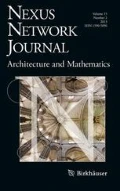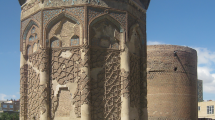Abstract
The twisted-cable type of patterns is found as Late Roman–Byzantine and early Umayyad floor patterns, with considerable uniformity in texture, colors, and technique. They consist of ‘cables’ which together form circles, circle segments, squares and other visually prominent ornamental elements. Cables mostly form complex closed loops, joined at points of local overlap by interlocking ‘knots’. The loops are the inconspicuous construction elements and several of them participate in each visually prominent segmented circle, square, etc. Majority of these patterns are tetragonal with chiral character, with predominant 2D layer-group symmetry p422. Other symmetries are rare, mostly in circular designs. Most of patterns were dichroically colored using local marbles. The combination of loops and knots generates broad versatility of design and a rich spectrum of extant patterns. The principal artistic heritage of this mosaic style are the Cosmatesque floor patterns of central Italy.

























Similar content being viewed by others
Notes
The term ‘cable’ for the ‘soft’ virtually cylindrical thread used in these patterns we adopt from Branzi-Maltoni et al. (2002).
References
Balmelle, C., L. Blanchard-Lemke, J., Christophe, J.-P. Darmon, A.-M. Guimier-Sorbets, H. Lavagne, R. Prudhomme and H. Stern. 2002. Le Décor Géométrique dela Mosaïque Romaine. Paris: Éditions A. et J. Picard.
Branzi-Maltoni, Raffaella, Monica Cardascia, Fabrizio Corbara and Silvia Zingaretti. 2002. Domus of Stone Carpets, Ravenna. Ravenna: RavennAntica.
Farioli, Raffaela. 1975. Pavimenti musivi de Ravenna paleocristiana. Ravenna: Longo Editore.
Makovicky, Emil. 2015. Crystallographic symmetries of ornamental floors in the Baptisteries of San Giovanni in Pisa and Firenze. Rend. Fis. Acc. Lincei, 26: 235-250.
Makovicky, Emil. 2016. Symmetry Through the Eyes of Old Masters. Berlin/Boston: De Gruyter.
Makovicky, Emil and Meghdad Ghari. 2018. Neither Simple nor Perfect: From Defect Symmetries to Conscious Pattern Variations in Islamic Ornamental Art. Symmetry: Culture and Science 29: 279-301.
Nassar, Mohammad. 2015. The Geometric Mosaics at Qusayr Amra in Context. Greek, Roman and Byzantine Studies 55: 414-430.
Nassar, Mohammad and Nizar Ali Turshan. 2011. Geometrical Mosaic Pavements of the Church of Bishop Leontios at Ya’amun (Northern Jordan). Palestine Exploration Quarterly 143(1): 41-62.
Pajares-Ayuela, Paloma. 2002. Cosmatesque Ornament: Flat Polychrome Geometric Patterns in Architecture. London: Thames & Hudson Ltd.
Perocco, Guido. 1974. The Basilica of Saint Mark. Venezia: Edizioni Storti.
Williams, Kim. 1997. Italian Pavements: Patterns in Space. Houston, Anchorage Press.
Acknowledgements
This paper profited from the suggestions of the journal editor and two anonymous referees. Assistance and understanding of my wife, Dr. Milota Makovicky, is gratefully acknowledged. Illustrations presented in the paper are based on author’s own photographs and graphic interpretations.
Author information
Authors and Affiliations
Corresponding author
Additional information
Publisher's Note
Springer Nature remains neutral with regard to jurisdictional claims in published maps and institutional affiliations.
Appendix: Chirality/Enantiomorphism
Appendix: Chirality/Enantiomorphism
A motif (object, pattern) which can exist in two forms which are non-superimposable images of one another is chiral. One everyday example is your right and left hands, which are related by reflection on a plane halving your body but not in the hands themselves. Chirality (from χειρος—hand) or enantiomorphism (εναντιος—opposite) [according to the science branch you consult] is important in mineralogy, solid-state science and physics, organic chemistry and especially in biochemistry, which is the world of chiral molecules.
Chiral objects (motifs, patterns) themselves do not contain reflection planes and/or centers of inversion (they lack internal mappings of the type x, y, z → x, − y, z and x, y, z → − x, − y, − z) and their symmetry operations can be described by (a set of) rotation axes of symmetry, e.g., as plane and layer groups p4, and p422, or as the symmetry of an ‘untreated’ natural quartz crystal, which has the point group 32. The two enantiomorphs can be ‘superimposed’ only in your imagination, using a reflection on an imaginary plane placed between them. Definition of the handedness, that is, whether the object is right- or left-handed, is important in physics and (bio)chemistry but may be irrelevant for the relatively scarce examples in the art. Problems arising from enantiomorphism in tile art were illustrated in Makovicky and Ghari (2018).
About this article
Cite this article
Makovicky, E. Byzantine Floor Patterns of Interlocking Twisted Cable Loops. Nexus Netw J 22, 449–469 (2020). https://doi.org/10.1007/s00004-019-00473-0
Published:
Issue Date:
DOI: https://doi.org/10.1007/s00004-019-00473-0




